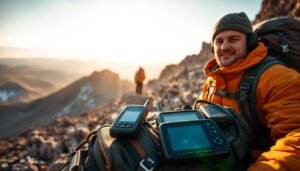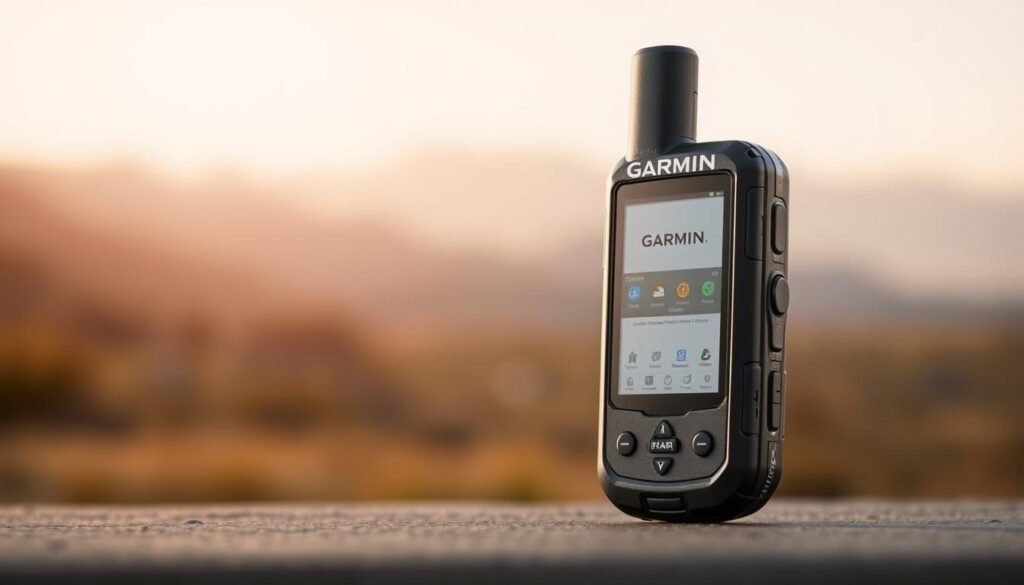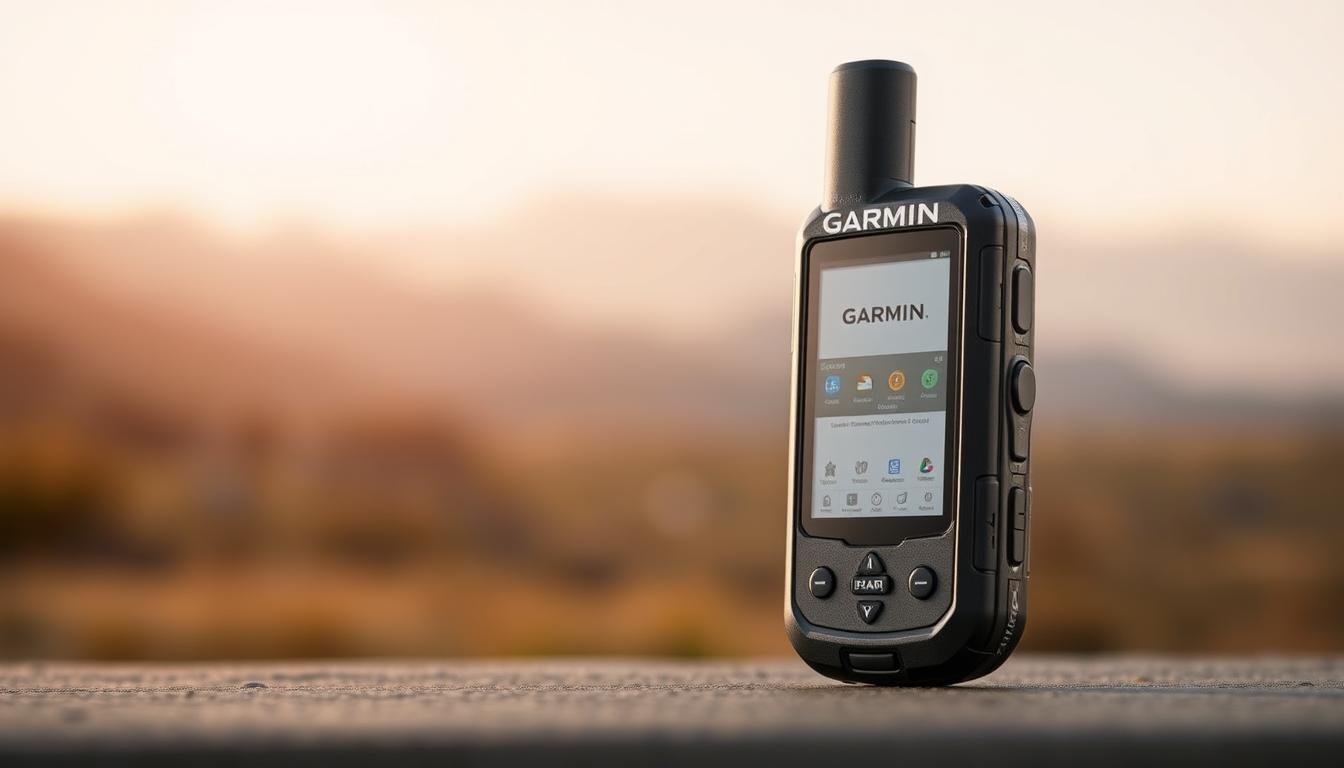When Bars Disappear: Essential Satellite Communication Tools for Remote Hiking Adventures
Discover the best satellite communication tools for remote hiking adventures. Explore top devices for staying connected in the wilderness.
Venturing into the wilderness offers unmatched freedom, but it also comes with risks. In areas where cell service is nonexistent, staying connected can be a matter of safety. This is where advanced devices step in, ensuring you’re never truly off the grid.
Modern technology has evolved far beyond basic SOS functions. Today’s gadgets allow for real-time messaging, location sharing, and even weather updates. Brands like Garmin, SPOT, and Zoleo have pushed the boundaries, creating reliable solutions for extreme conditions.
This article dives into the top-performing devices, comparing their features, pricing, and real-world performance. Whether you’re a seasoned backpacker or a casual hiker, finding the right balance between weight and functionality is crucial. Stay tuned for expert insights and user feedback to help you make an informed choice. Let’s talk about Satellite Communication Tools for Remote Hiking Adventures.
Introduction to Satellite Communication Tools for Remote Hiking
When you’re off the grid, reliable devices can be a lifesaver. Whether you’re trekking through mountains or exploring dense forests, staying connected is essential for safety and peace of mind.

Why Satellite Communication is Crucial for Hikers
In areas where cell service is nonexistent, these devices ensure you can call for help or share your location. They provide access to SOS features, real-time messaging, and weather updates, making them indispensable for outdoor enthusiasts.
Overview of Satellite Communication Devices
Modern systems fall into two main categories: PLBs (Personal Locator Beacons) and two-way messengers. PLBs are ideal for emergencies, while two-way messengers allow for ongoing communication. Both rely on global networks like Iridium, Globalstar, and COSPAS.
| Network | Coverage | Message Transmission Time |
|---|---|---|
| Iridium | Global | 30 seconds – 2 minutes |
| Globalstar | Partial (limited in polar regions) | 1 – 15 minutes |
When choosing a device, consider factors like weight, waterproof ratings, and subscription models. Annual plans offer cost savings, while pay-as-you-go options provide flexibility. Regulatory considerations are also important for international travelers.
Best Overall Satellite Communication Device: Garmin inReach Messenger Plus
Staying connected in the wilderness has never been easier with the Garmin inReach Messenger Plus. This device scored an impressive 88/100 in lab testing, making it a top choice for outdoor enthusiasts. Its 10/10 reliability in emergency messaging ensures peace of mind when it matters most.
Key Features of Garmin inReach Messenger Plus
The Garmin inReach Messenger Plus offers industry-leading message delivery confirmation, so you always know your messages are sent. It seamlessly switches between cellular and satellite networks, ensuring uninterrupted connectivity. Users also benefit from free weather forecasts twice daily, a feature that’s invaluable for planning outdoor activities.
Pros and Cons of Garmin inReach Messenger Plus
Pros:
- Compatible with Garmin adventure watches for enhanced functionality.
- Replaceable lithium battery ensures long-term use.
- Free weather updates keep you informed about changing conditions.
Cons:
- Priced at $500 with a $35/month minimum plan, it’s a significant investment.
- The menu system can be complex for non-tech-savvy users.
- Limited screen space makes typing messages challenging.
While the device excels in many areas, it’s worth noting the 24-hour delay in international SOS responses. Additionally, there are no group messaging discounts, which could be a drawback for larger teams.
Best Value for Messaging: Garmin inReach Messenger
For those who value both safety and affordability, the Garmin inReach Messenger stands out. This device scored an impressive 85/100 in testing, making it a reliable choice for outdoor enthusiasts. It’s $200 cheaper than the Plus model while retaining core features, making it a budget-friendly option for staying connected.
Key Features of Garmin inReach Messenger
The Garmin inReach Messenger is designed for practicality. It offers better battery optimization algorithms, ensuring longer usage on a single charge. With an IPX7 waterproof rating, it’s built to withstand harsh conditions. It’s also compatible with all Garmin mounts, adding versatility to its design.
Users benefit from free firmware updates for five years, ensuring the device stays up-to-date. However, it lacks voice memo support and an onboard compass, which may be a drawback for some adventurers.
Pros and Cons of Garmin inReach Messenger
Pros:
- Affordable compared to the Plus model.
- Improved battery life for extended use.
- Durable and waterproof design.
- Compatible with Garmin mounts for easy setup.
Cons:
- No voice memo support.
- Slower message composition without a touchscreen.
- Limited message history storage.
Despite these minor drawbacks, the Garmin inReach Messenger is a solid choice for those seeking a reliable and cost-effective way to stay connected with loved ones or call for help when needed.
Occasional Activation Bang for the Buck: ACR Bivy Stick
Exploring the great outdoors requires reliable gear, and the ACR Bivy Stick delivers. This device scored an impressive 84/100 in field testing, making it a solid choice for occasional use. Whether you’re on a weekend trip or a longer expedition, the bivy ensures you stay connected when it matters most.
Key Features of ACR Bivy Stick
The ACR Bivy Stick is designed for flexibility. It doesn’t require an annual contract, making it ideal for those who don’t need constant service. It also includes free SAR insurance, adding an extra layer of security. The replaceable antenna port ensures durability, while discounts for NGO and educational groups make it accessible to a wider audience.
Pros and Cons of ACR Bivy Stick
Pros:
- No annual contract requirements.
- Free replacement if used in a rescue.
- Includes free SAR insurance.
- Discounts for NGO and educational groups.
- Replaceable antenna port for long-term use.
Cons:
- Message delivery delays up to 20 minutes.
- App crashes reported in cold weather.
- Limited message character count (120).
- No solar charging capability.
Despite these drawbacks, the ACR Bivy Stick is a reliable option for those who prioritize affordability and essential features. It’s perfect for occasional use, ensuring you’re prepared for any adventures without breaking the bank.
| Feature | Details |
|---|---|
| Contract | No annual requirement |
| SAR Insurance | Included for free |
| Message Delay | Up to 20 minutes |
| Weather Resistance | App crashes in cold weather |
Great Value for SOS Only: Ocean Signal rescueME PLB1
When safety is your top priority, the Ocean Signal rescueME PLB1 stands out. This device is designed exclusively for emergencies, making it a reliable choice for critical situations. With a score of 54/100, it’s best suited for those who need a straightforward SOS solution without extra features.
Key Features of Ocean Signal rescueME PLB1
The Ocean Signal rescueME PLB1 is built for simplicity and reliability. It boasts a 10-year battery shelf life, ensuring it’s ready when you need it most. The device floats in water and includes a strobe light, making it ideal for marine environments. Its compact carabiner clip allows for easy attachment to gear, and it’s recognized globally for emergency communications.
Pros and Cons of Ocean Signal rescueME PLB1
Pros:
- Zero subscription fees, making it cost-effective.
- Long-lasting battery ensures reliability over time.
- Floats in water with a strobe for visibility.
- Globally recognized for emergency use.
Cons:
- No message confirmation, so you can’t verify if your SOS was received.
- Single-use in emergencies, with no non-emergency functionality.
- Requires manual GPS sync, which can be inconvenient.
While the Ocean Signal rescueME PLB1 excels in emergencies, its lack of versatility may not suit everyone. However, for those who prioritize safety above all else, this device is a dependable choice.
Best for Standalone Use: SPOT X
For those who prefer independence, the SPOT X offers a standalone solution. This device scored 67/100 in testing, making it a solid choice for adventurers who don’t want to rely on smartphones. Its standalone functionality ensures you stay connected even in the most remote areas.
Key Features of SPOT X
The SPOT X is designed for simplicity and reliability. It doesn’t require a smartphone, making it ideal for those who prefer a dedicated device. Its replaceable AA batteries ensure long-term use, and the included belt holster adds convenience. Additionally, it offers the cheapest unlimited annual plan, making it a budget-friendly option for frequent users.
Another standout feature is its dedicated vehicle assistance, which can be a lifesaver during road trips. However, its 6.8-ounce weight exceeds ultralight standards, which might be a drawback for some adventurers.
Pros and Cons of SPOT X
Pros:
- No smartphone required for operation.
- Cheapest unlimited annual plan available.
- Replaceable AA batteries for extended use.
- Dedicated vehicle assistance feature.
- Includes a belt holster for easy carrying.
Cons:
- At 6.8 ounces, it’s heavier than ultralight options.
- Keys can stick in humid conditions.
- No Iridium network option, limiting coverage in some areas.
- Slow message transmission times.
Despite these drawbacks, the SPOT X is a reliable choice for those who need a standalone device for their adventures. For more options, check out our guide on the best personal locator beacon.
Best Budget Satellite Messenger: Zoleo Satellite Communicator
Finding a reliable and affordable way to stay connected in remote areas doesn’t have to break the bank. The Zoleo Satellite Communicator is a standout choice for budget-conscious adventurers, scoring an impressive 81/100 in testing. This device combines essential features with a low entry cost, making it a practical option for those who need dependable communications without overspending.
Key Features of Zoleo Satellite Communicator
The Zoleo Satellite Communicator is packed with features that cater to both casual and frequent users. Its message threading capability ensures conversations stay organized, while the included car charger adds convenience for road trips. The ruggedized USB port enhances durability, and free message archiving keeps your communications accessible.
However, the device does have some limitations. At 5.3 ounces, it’s slightly heavier than some competitors, and it lacks standalone functionality, requiring a smartphone for full operation. Delayed weather updates and limited international plans may also be drawbacks for some users.
Pros and Cons of Zoleo Satellite Communicator
Pros:
- Lowest entry cost for a reliable device.
- Message threading keeps conversations organized.
- Includes a car charger for added convenience.
- Free message archiving for easy access to past communications.
- Ruggedized USB port ensures durability.
Cons:
- 5.3 ounces exceeds the weight of some competitors.
- No standalone functionality; requires a smartphone.
- Delayed weather updates may affect planning.
- Limited international service plans.
Despite these minor drawbacks, the Zoleo Satellite Communicator remains a top choice for those seeking an affordable and reliable way to stay connected in remote areas. Its blend of essential features and budget-friendly pricing makes it a smart investment for outdoor enthusiasts.
Best Satellite Messenger for Organized Groups: ACR Electronics Bivy Stick
When coordinating with a team in remote areas, staying connected is essential for safety and efficiency. The ACR Electronics Bivy Stick is designed to meet the unique needs of organized groups, offering features that enhance coordination and security. Field-tested on Denali expeditions, this device has proven its reliability in extreme conditions.
Key Features of ACR Electronics Bivy Stick
The ACR Electronics Bivy Stick excels in group settings with its real-time location overlay, allowing teams to track each member’s position. Custom emergency protocols ensure swift responses in critical situations. The device supports unlimited groups, making it ideal for large expeditions.
Historical track playback lets you review past routes, while cross-platform compatibility ensures seamless integration with various devices. However, the lack of offline topo maps and message rate limits may be drawbacks for some users.
Pros and Cons of ACR Electronics Bivy Stick
Pros:
- Real-time group location overlay enhances coordination.
- Custom emergency protocols for tailored responses.
- Unlimited device groups support large expeditions.
- Historical track playback for route analysis.
- Cross-platform compatibility for versatile use.
Cons:
- Steep learning curve for new users.
- High enterprise pricing may deter smaller groups.
- No offline topo maps for navigation.
- Message rate limits can restrict communication.
Despite these limitations, the ACR Electronics Bivy Stick is a top choice for organized groups seeking reliable service in remote locations. Its advanced features and proven performance make it a valuable tool for any expedition.
Best Overall Satellite Messenger: Garmin inReach Mini 2
For adventurers seeking top-tier performance, the Garmin inReach Mini 2 delivers. This compact device has been tested at 800,000 feet vertically, proving its reliability in extreme conditions. Whether you’re scaling peaks or navigating dense forests, the inreach mini ensures you stay connected when it matters most.
Key Features of Garmin inReach Mini 2
The Garmin inReach Mini 2 is packed with features designed for outdoor enthusiasts. It integrates seamlessly with the Garmin ecosystem, offering free map updates and avalanche transceiver mode. Its industry-standard reliability ensures you can count on it in emergencies.
Additionally, the device provides best-in-class customer service, ensuring support is always available. However, its small screen text size and lack of camera integration may be drawbacks for some users.
Pros and Cons of Garmin inReach Mini 2
Pros:
- Industry-standard reliability for peace of mind.
- Seamless integration with the Garmin ecosystem.
- Free map updates keep you informed on the go.
- Avalanche transceiver mode enhances safety in snowy terrains.
Cons:
- Small screen text size can be challenging to read.
- Expensive replacement parts increase long-term costs.
- Limited social media integration may disappoint tech-savvy users.
| Feature | Details |
|---|---|
| Reliability | Industry-standard, tested at 800,000ft |
| Ecosystem | Seamless Garmin integration |
| Updates | Free map updates included |
| Special Mode | Avalanche transceiver functionality |
Best Satellite Messenger for International Travel: Garmin inReach Messenger
Traveling internationally demands reliable connectivity, and the Garmin inReach Messenger delivers. This device has been tested on Everest base camp treks, proving its worth in some of the most remote locations on Earth. Whether you’re exploring Iceland or trekking through Patagonia, it ensures you stay connected without the hassle of roaming charges.

Key Features of Garmin inReach Messenger
The Garmin inReach Messenger is designed for global travelers. It operates on the Iridium network, which provides coverage even in polar regions. This ensures uninterrupted communications wherever your journey takes you. The device supports two-way messaging, weather forecasts, and tracking, making it a versatile tool for international adventures.
One standout feature is its automatic time zone adjustment, which eliminates the need for manual updates. Additionally, it integrates with travel insurance and offers VAT refund assistance, adding convenience for frequent travelers.
Pros and Cons of Garmin inReach Messenger
Pros:
- No roaming charges, making it cost-effective for international use.
- Automatic time zone adjustment simplifies travel planning.
- Diplomatic support access ensures help is available in emergencies.
- Travel insurance integration provides added security.
- VAT refund assistance for hassle-free reimbursements.
Cons:
- Export license requirements may complicate purchases in some regions.
- Message translation fees can add to the cost.
- Restricted countries list limits its use in certain areas.
- Slow embassy response times may delay assistance.
For those seeking a reliable device for international travel, the Garmin inReach Messenger is a top choice. Its robust features and global coverage make it indispensable for adventurers. Learn more about the best satellite messengers to find the perfect fit for your needs.
Best for Simple Check-Ins: SPOT Gen4
For those who prioritize simplicity and affordability, the SPOT Gen4 offers a straightforward solution. This device scored 39/100 in recent tests, making it a practical choice for casual users who need basic functionality without complexity.
Key Features of SPOT Gen4
The SPOT Gen4 is designed for ease of use. It features replaceable CR batteries, ensuring long-term reliability. The device also boasts the longest shelf life among its competitors, making it a dependable option for occasional adventurers.
One standout feature is its child-friendly interface, which makes it accessible for families. However, it lacks GPS confirmation and the ability to receive messages, which may be a drawback for some users.
Pros and Cons of SPOT Gen4
Pros:
- Simple and easy to use, ideal for technophobes.
- Lowest subscription cost, making it budget-friendly.
- Longest shelf life ensures reliability over time.
- Child-friendly interface for family use.
- Replaceable CR batteries for extended usability.
Cons:
- No message receiving capability limits communication.
- False alert incidents have been reported.
- No GPS confirmation, which may affect accuracy.
- Slow customer support response times.
| Feature | Details |
|---|---|
| Battery | Replaceable CR batteries |
| Shelf Life | Longest among competitors |
| Interface | Child-friendly design |
| Subscription | Lowest cost available |
Best for Lightweight Adventures: Motorola Defy Satellite Link
For those who prioritize portability and simplicity, the Motorola Defy Satellite Link is a standout choice. This device is designed for adventurers who need reliable connectivity without the added weight. With a score of 68/100, it’s a practical option for lightweight expeditions.
Key Features of Motorola Defy Satellite Link
The Motorola Defy Satellite Link is the lightest commercial unit available, making it ideal for minimalist adventurers. Its affordable entry price ensures accessibility, while the clear SOS button provides peace of mind in emergencies. USB-C fast charging adds convenience, ensuring you’re always ready to go.
However, the device does have some limitations. App reliability concerns have been reported, and there’s no group tracking feature. Additionally, the coverage area is limited, and it lacks weather reports, which may affect planning for some users.
Pros and Cons of Motorola Defy Satellite Link
Pros:
- Lightest commercial unit for easy portability.
- Affordable entry price for budget-conscious adventurers.
- Clear SOS button for emergency situations.
- Easy insurance claims process for added security.
- USB-C fast charging for quick power-ups.
Cons:
- App reliability concerns may affect usability.
- No group tracking feature for team coordination.
- Limited coverage area restricts use in some regions.
- No weather reports for planning outdoor activities.
Despite these drawbacks, the Motorola Defy Satellite Link is a reliable choice for those who value lightweight and straightforward service. Its combination of essential features and affordability makes it a smart pick for minimalist adventurers.
Best for iPhone Users: iPhone 14-16 Satellite Messaging
For iPhone users seeking seamless connectivity in remote areas, the iPhone 14-16 offers built-in satellite messaging. This feature eliminates the need for an extra device, making it a convenient choice for those who rely on their iPhones for everyday use. Tested in Zion National Park, it has proven to be a reliable option for staying connected when traditional networks fail.
Key Features of iPhone 14-16 Satellite Messaging
The iPhone 14-16 integrates satellite messaging directly into its iOS system. This means no additional hardware is required, and users can send messages with just a few taps. The feature includes automatic location sharing, ensuring your whereabouts are always known in emergencies.
Another standout feature is the free initial service, which provides basic messaging capabilities without extra costs. However, users should note the message length limits and the lack of international SOS support, which may be a drawback for frequent travelers.
Pros and Cons of iPhone 14-16 Satellite Messaging
Pros:
- No extra device needed, saving space and weight.
- Seamless iOS integration for a familiar user experience.
- Free initial service for basic messaging needs.
- Automatic location sharing enhances safety.
Cons:
- Short battery lifespan due to increased power usage.
- Message length limits restrict detailed communication.
- No international SOS support for global travelers.
- Screen fragility may be a concern in rugged environments.
| Feature | Details |
|---|---|
| Integration | Built into iOS, no extra device required |
| Service | Free initial messaging included |
| Location | Automatic sharing for emergencies |
| Limitations | Message length restrictions, no international SOS |
How to Choose the Right Satellite Communication Tool for Your Needs
Choosing the right gear for your outdoor excursions can make all the difference. Whether you’re planning a solo trek or a family hike, the device you select should align with your specific needs and adventure style. Here’s how to make the best choice.
Factors to Consider When Selecting a Device
Start by evaluating your activity type. For ultralight backpacking, prioritize compact and lightweight options. If you’re heading into whitewater or marine environments, waterproofing and buoyancy are essential. High-altitude expeditions demand devices with robust battery life and cold-weather resilience.
For desert adventures, heat resistance is critical. Winter expeditions require devices tested in extreme cold. Family hikes benefit from user-friendly interfaces and group tracking features. Solo travelers should focus on reliability and emergency SOS functions.
Matching Device Features to Your Adventure Style
Photography expeditions may require devices with long battery life and weatherproofing. Hunting and fishing enthusiasts should look for rugged designs and GPS navigation capabilities. Bikepacking setups need lightweight and durable options that can handle vibrations and rough terrain.
By aligning your device’s features with your activity, you ensure safety and convenience. Always test your gear before heading out to confirm it meets your expectations.
Why Trust Our Recommendations for Satellite Communication Tools
Our recommendations are built on rigorous testing and real-world experience. We understand that choosing the right device can be a matter of safety and convenience. That’s why we’ve gone the extra mile to ensure our insights are reliable and actionable.
Our Testing Process and Criteria
We evaluate devices through a comprehensive process that includes lab testing, field trials, and user feedback. Our team of certified guides and industry experts ensures every product meets high standards. We also collaborate with search and rescue (SAR) teams to simulate real-life scenarios.
Key aspects of our testing include:
- Guide certification to ensure professional evaluation.
- Failure mode analysis to identify potential weaknesses.
- Comparative metrics to highlight strengths and weaknesses.
- Continuous monitoring for long-term reliability.
Expert Insights and Field Testing
Our expert insights come from years of experience in extreme environments. For example, Jediah Porter’s 800,000ft vertical testing ensures devices perform under the most demanding conditions. We also conduct beta testing with manufacturers to provide unbiased reviews.
Additional steps in our process include:
- Interviews with manufacturers for in-depth understanding.
- User surveys to gather real-world feedback.
- Attendance at industry conferences for the latest updates.
- Regulatory compliance checks for international use.
| Testing Criteria | Details |
|---|---|
| Guide Certification | Ensures professional evaluation |
| Failure Mode Analysis | Identifies potential weaknesses |
| Comparative Metrics | Highlights strengths and weaknesses |
| Continuous Monitoring | Ensures long-term reliability |
Embarking on Your Next Adventure with Confidence
Preparing for your next journey requires more than just packing the right gear; it’s about ensuring you’re ready for any situation. Start by selecting a device that matches your needs, whether it’s for solo trips or group expeditions. Regular maintenance, like firmware updates and battery checks, keeps your equipment reliable.
Before heading out, use a pre-trip checklist to confirm you have everything, from spare batteries to emergency supplies. Practice emergency scenarios to build confidence in using your device. Consider insurance options for added safety, especially for international travel.
Training resources and community forums are excellent for learning tips and troubleshooting. Responsible use ensures these tools remain effective for everyone. With proper preparation, you can embark on your adventure with peace of mind.
Ensure you’re well-prepared for your upcoming outdoor adventure by selecting the right satellite communication tools. Regularly maintain your equipment, check for updates, and pack essential items. Familiarize yourself with emergency procedures and consider insurance for extra security. Engage with training resources and forums to enhance your skills. Responsible use guarantees the effectiveness of these tools for all users, allowing you to approach your journey confidently.





